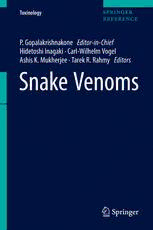
Snake Venoms PDF
Preview Snake Venoms
Toxinology P. Gopalakrishnakone Editor-in-Chief Hidetoshi Inagaki Carl-Wilhelm Vogel Ashis K. Mukherjee Tarek Rashed Rahmy Editors Snake Venoms 1 3 Reference Toxinology Editor-in-Chief P.Gopalakrishnakone Inrecentyears,thefieldoftoxinologyhasexpandedsubstantially.Ontheonehandit studiesvenomousanimals,plantsandmicroorganismsindetailtounderstandtheir mode of action on targets. While on the other, it explores the biochemical compo- sition,genomicsandproteomicsoftoxinsandvenomstounderstandtheirinteraction with life forms (especially humans), development of antidotes and exploring their pharmacological potential. Therefore, toxinology has deep linkages with biochem- istry, molecular biology, anatomy and pharmacology. In addition, there is a fast- developingappliedsubfield,clinicaltoxinology,whichdealswithunderstandingand managingmedicaleffectsoftoxinsonhumanbody.Giventhehugeimpactoftoxin- based deaths globally, and the potential of venom in generation of drugs for so-far incurablediseases(forexample,diabetes,chronicpain),thecontinuedresearchand growthofthefieldisimminent.Thishasledtothegrowthofresearchintheareaand the consequent scholarly output by way of publications in journals and books. Despite this ever-growing body of literature within biomedical sciences, there is still no all-inclusive reference work available that collects all of the important biochemical,biomedicalandclinicalinsightsrelatingtotoxinology. Composed of 12 volumes, Toxinology provides comprehensive and authoritative coverage of the main areas in toxinology, from fundamental concepts to new developments and applications in the field. Each volume comprises a focused and carefullychosencollectionofcontributionsfromleadingnamesinthesubject. SeriesTitles 1. BiologicalToxinsandBioterrorism 2. ClinicalToxinologyintheAsiaPacificandAfrica 3. SpiderVenoms 4. ScorpionVenoms 5. MarineandFreshwaterToxins 6. VenomGenomicsandProteomics 7. SnakeVenoms 8. EvolutionofVenomousAnimalsandTheirVenoms 9. MicrobialToxins 10. PlantToxins 11. ToxinsandDrugDiscovery 12. ClinicalToxinologyinAustralia,Europe,andAmericas Moreinformationaboutthisseriesathttp://www.springer.com/series/13330 P. Gopalakrishnakone Editor-in-Chief (cid:129) Hidetoshi Inagaki Carl-Wilhelm Vogel (cid:129) Ashis K. Mukherjee Tarek R. Rahmy Editors Snake Venoms With87Figuresand32Tables Editor-in-Chief P.Gopalakrishnakone VenomandToxinResearchProgramme DepartmentofAnatomy YongLooLinSchoolofMedicine NationalUniversityofSingapore Singapore,Singapore Editors HidetoshiInagaki Carl-WilhelmVogel BiomedicalResearchInstitute UniversityofHawaiiCancerCenter NationalInstituteofAdvancedIndustrial Honolulu,HI,USA ScienceandTechnology(AIST) Tsukuba,Ibaraki,Japan AshisK.Mukherjee TarekR.Rahmy DepartmentofMolecularBiologyand SuezCanalUniversity Biotechnology,ResearchandDevelopment Ismailia,Egypt ONGC-CentreforPetroleumBiotechnology DBTNodalCentreforMedicalCollegesand BiomedicalResearchInstitutesofNorth-East India(UnitofDepartmentofBiotechnology Govt.ofIndia) TezpurUniversity Tezpur,Assam,India ISBN978-94-007-6409-5 ISBN978-94-007-6410-1(eBook) ISBN978-94-007-6411-8(printandelectronicbundle) DOI10.1007/978-94-007-6410-1 LibraryofCongressControlNumber:2016952865 #SpringerScience+BusinessMediaDordrecht2017 Thisworkissubjecttocopyright.AllrightsarereservedbythePublisher,whetherthewholeorpartofthe materialisconcerned,specificallytherightsoftranslation,reprinting,reuseofillustrations,recitation, broadcasting,reproductiononmicrofilmsorinanyotherphysicalway,andtransmissionorinformation storageandretrieval,electronicadaptation,computersoftware,orbysimilarordissimilarmethodology nowknownorhereafterdeveloped. Theuseofgeneraldescriptivenames,registerednames,trademarks,servicemarks,etc.inthispublication doesnotimply,evenintheabsenceofaspecificstatement,thatsuchnamesareexemptfromtherelevant protectivelawsandregulationsandthereforefreeforgeneraluse. Thepublisher,theauthorsandtheeditorsaresafetoassumethattheadviceandinformationinthisbook arebelievedtobetrueandaccurateatthedateofpublication.Neitherthepublishernortheauthorsorthe editorsgiveawarranty,expressorimplied,withrespecttothematerialcontainedhereinorforanyerrors oromissionsthatmayhavebeenmade. Printedonacid-freepaper ThisSpringerimprintispublishedbySpringerNature TheregisteredcompanyisSpringerScience+BusinessMediaB.V. Theregisteredcompanyaddressis:VanGodewijckstraat30,3311GXDordrecht,TheNetherlands Series Preface The term TOXIN is derived from the Greek word Toeikov and is defined as a substance derived from tissues of a plant, animal, or microorganism that has a deleterious effect on other living organisms. Studying their detailed structure, function, and mechanism of action as well as finding an antidote to these toxins is thefieldofTOXINOLOGY,andthescientistsarecalledTOXINOLOGISTS. In recent years, the field of toxinology has expanded substantially. On the one hand, it studies venomous animals, plants, and microorganisms in detail to under- standtheirhabitat,distribution,identification,aswellasmodeofactionontargets, whileontheother,itexploresthebiochemicalcomposition,genomics,andproteo- micsoftoxinsandvenomstounderstandtheirinteractionwithlifeforms(especially humans),thedevelopmentofantidotes,andtheirpharmacologicalpotentialfordrug discovery. Therefore, toxinology has deep linkages with biochemistry, molecular biology,anatomy,pharmacology,etc.Inaddition,thereisafastdevelopingapplied subfield,clinicaltoxinology,whichdealswithunderstandingandmanagingmedical effects of venoms and toxins on the human body following envenomations. Given thehugeimpactofenvenomation-baseddeathsgloballyandthepotentialofvenom inthegenerationofdrugsfordebilitatingdiseases(e.g.,diabetes,chronicpain,and cancer),thecontinuedresearchandgrowthofthefieldisimminent. Springerhastakentheboldinitiativeofproducingthisseries,whichisnotaneasy target of producing about 12 volumes, namely, biological toxins and bioterrorism, clinical toxinology, scorpion venoms, spider venoms, snake venoms, marine and freshwater toxins, toxins and drug discovery, venom genomics and proteomics, evolutionofvenomousanimalsandtheirtoxins,planttoxins,andmicrobialtoxins. Singapore P.Gopalakrishnakone M.B.B.S.,Ph.D.,F.A.M.S.,D.Sc. Editor-in-Chief v Acknowledgments Iwouldliketosincerelythankthesectioneditorsofthisvolume,HidetoshiInagaki, Carl-Wilhelm Vogel, Ashis K. Mukherjee, and Tarek R. Rahmy for the invaluable contributionoftheirexpertiseandtimeandtheauthorswhoobligedwithmyrequest andprovidedacomprehensivereviewonthetopics. Springerprovidedsubstantialtechnicalandadministrativehelpbymanyindivid- ualsatvaryinglevels,butspecialmentionshouldgotoSarahMathews,SunaliMull, MeghnaSingh,MokshikaGaur,andAudreyWongfortheirtirelesseffortinbringing thesevolumestoreality. Singapore P.Gopalakrishnakone MBBS,PhD,FAMS,DSC Editor-in-Chief vii Volume Preface Asweseewith theRodofAsclepiusinGreekmythology,ancientpeoplebelieved thatsnakeshavemysticalpowerstohealillnessviatheirvenoms,eventhoughthey didnotknowtheessenceofthesepowers.Sinceabout100yearsago,newtechnol- ogieshavebeendevelopedtoanalyzethecomponents,structures,andphysiological functions of snake venoms, and we have gradually figured out the essence of the powers.Furthermore,wecanobtainvariousdiagnosticandtherapeuticagentsfrom snakevenoms. Initially, because of the inadequate sensitivity of devices and other limitations, only major venom components of the dominant species were studied. However, in the last two decades, increased sensitivity of devices and the development of new techniques,suchastranscriptomicsandproteomicstechniques,havepermittedusto analyze the structures and functions of rare species and to identify novel minor components.Asaresult,thenumberofvenomcomponentsidentifiedisincreasing dramaticallyandwecanunderstandthephysiologicalfunctionsofeachcomponent moredeeply. The scope of this book provides the readers an updated and comprehensive presentation on snake venoms. The subjects are divided into six sections, starting with the overview of snake venom compositions in Malaysian species. We then describe the enzymes and enzyme inhibitors contained in snake venoms. We also discuss the effects of snake venom on cellular receptors, ion channels, blood, and lymph, as well as cytotoxic and antimicrobial molecules present in snake venoms. Thelastsectioncoverstheclinicalconsequencesofenvenomationandthemanage- mentofsnakebitesusingantivenins. We would like to express our appreciation to all the authors for contributing to thisprojectandprovidingtheirscientificknowledge.Weareparticularlyindebtedto Professor Gopalakrishnakone of the National University of Singapore, who started upandadvancedthisproject,andallowedustocontribute.Finally,wewouldliketo thankMeghnaSingh,SunaliMull,SarahMathews,andAudreyWongofSpringer, whopatientlysupportedusonthisproject. ix x VolumePreface StatueofAsclepius,exhibitedintheMuseumofEpidaurusTheatre,inArgolisonthePeloponnese peninsula,Greece(PhotobyMichaelF.Mehnert(Ownwork)(GFDL[http://www.gnu.org/copyleft/ fdl.html]orCCBY-SA3.0[http://creativecommons.org/licenses/by-sa/3.0]),viaWikimediaCommons) January2017 UniversityofHawaiiCancerCenter Carl-WilhelmVogelM.D.,Ph.D. Honolulu,HI,USA DepartmentofMolecularBiologyand AshisK.MukherjeePh.D. Biotechnology,ResearchandDevelopment ONGC-CentreforPetroleumBiotechnology DBTNodalCentreforMedicalCollegesand BiomedicalResearchInstitutesofNorth-EastIndia (UnitofDepartmentofBiotechnology,Govt.ofIndia) TezpurUniversity Tezpur,Assam,India VolumePreface xi BiomedicalResearchInstitute HidetoshiInagakiPh.D. NationalInstituteofAdvancedIndustrial ScienceandTechnology(AIST) Tsukuba,Ibaraki,Japan SuezCanalUniversity TarekR.RahmyPh.D. Ismailia,Egypt
